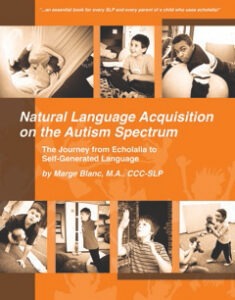Supports: Stage 3
Something big happens at Stage 3, and the research has borne this out. Barry Prizant considered it the stage when gestalt language processing in his autistic subjects gave way to more analytic language processing.
Marge Blanc found it to be equally dramatic and verified that it is part of the language development trajectory of the gestalt language processors she followed throughout her clinical research.
Is it a hemispheric shift we have yet to verify? Behaviorally, we would not be surprised if it is. Once Stage 3 emerges, single words are isolated from mitigations, and referential naming and first self-generated semantic relationships quickly follow.
At this magic juncture, GLPs achieve what we naïvely thought they should have from the beginning, before processing language at all: specifically pointing and referencing. The NLA community knows better now: that GLP infants extract gestalts from the sound stream around them before they point or reference.
GLPs have long been considered disordered ALPs. The conventional wisdom has been that ALPs had to achieve pre-verbal communication in order to be ready for verbal/language communication. So when GLPs are not referential (pointing and referencing) until NLA Stage 3, we need to acknowledge that they should not be expected to! GLPs are verbal before they are referential — but since we have not considered unintelligible ‘echolalia’ as ‘verbal,’ we were misguided. Now we can ‘know better and can do better.’
In summary, believe your child! If they are not interested in pointing, if they do not initiate pointing, we do them no service by expecting them to. They might ‘echo’ gestures they see within a experience (like a video), but those gestures are part of the ‘gestalt.’ (Think ‘head, shoulders, knees and toes’ song)
Let GLPs develop the way they’re neurology determined, and save referential pointing for Stage 3. Our kids will lead the way, as they always do, in natural language development.
Supports at Stage 3 include these:
- First, believe in natural language development, and believe in your chid. As parents have verified, over and over again, natural language development for GLPs is real!
- Know when your child is likely ready for Stage 3. As we have said, inventory Stage 2 utterances, types of utterances, and intentions. Watch for the 50% criteria of Stage 2 utterances before thinking your child might be ready for Stage 3. They lead us, but you can be ready to watch for the signs.
- Listen for your child’s first single-word isolation. It may sound like an utterance is slowing down like Dylan’s first Stage 3 utterance: “I ….. toy!” or like another little one I know who was building Lego fences and talking fluently, and then paused and deliberately said, “Three …… wood.”
- Just stay calm and continue the conversation, but use a few word + word combos yourself, just to let your child ‘know that you know’ what’s going on and that it’s good.
- Know that you might not hear another word + word combo again that day — but you might. Either way, it’s fine
- Listen for single word isolation. That’s a good sign, and you can follow your child’s lead by adding a few yourself.
- You can point as you do so!
- Also know that ‘referencing’ doesn’t have to be pointing. It can be eye gaze, or body proximity, or holding out the item being referred to.
- Partner with your child to play with single words, and word + word combos. Look at your environment and slowly and deliberately reference one thing … then another thing.
- Look at your DST chart and play with 2-word combos that you can see, hear, touch, or read — nouns, attributes, locations: book + floor, floor + chair, red + book, window + kitty, outside + window, kitty + furry, kitty + there, it + kitty, it + dark, light + it, I + kitty, outside + we. Two ideas relate, and two words reflect their relationship (‘semantic relationship’). That’s what self-generated language does.
- Know that Stage 3 isolated words and combos may lack intonation. That’s ok. In fact, that may be your signal that the child is referencing single words and not ‘echoing’ anything.
- Think about any little bundles of words that need to be taken apart into single words at Stage 3 or beginning Stage 4. [There are exceptions, since some contractions doesn’t get constructed until later in Stage 4. ‘Let’s’ = ‘let’ + ‘us’ and ‘Don’t’ = ‘do’ + ‘not’ and ‘Can’t’ = ‘can’ + ‘not’ etc., but don’t worry about them yet; just try to avoid using them too much in your language models]
- Be deliberate. This is word + word combinations, not phrases. No grammar. No verbs. Save that for Stage 4. Do this Stage well. As best possible, every word that your child used at Stages 1 and 2 needs to be ‘freed up,’ taken out of gestalts and mitigations, and used individually, either now or as your child transitions to Stage 4.
- The older the child at Stage 3, the longer they may want to stay there. This is good. Read Bevin’s story in the NLA book. That will inspire you!
- Have fun. This is a natural Stage whether it seems like it to adults or not! We have seen teenagers love this Stage because it’s really an intellectual exercise! So, enjoy it with your child.
